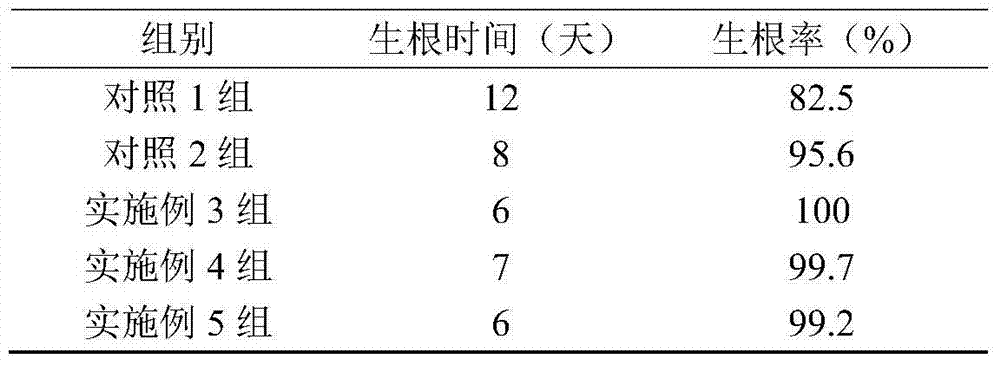Hydrangea cuttage reproduction method
A technology of cutting propagation and hydrangea, which is applied in the directions of botanical equipment and methods, horticulture, plant cultivation, etc., can solve the problems of long rooting time, low rooting rate, low yield, etc. Effects of reproductive output
- Summary
- Abstract
- Description
- Claims
- Application Information
AI Technical Summary
Problems solved by technology
Method used
Image
Examples
Embodiment 1
[0022] (1) Cutting substrate selection: choose river sand as the main cutting substrate, and also include perlite and vermiculite, the weight ratio of the river sand, perlite and vermiculite is 2:1:1, and the thickness is 16cm;
[0023] (2) Selection of cuttings: the cuttings are selected from the semi-lignified branches of the year, the length is not limited, and the diameter of the cuttings is greater than 5mm;
[0024] (3) Cutting: cut each section, leave 1cm above the section, leave 0.5cm below the section, keep half of the blade, cut each section from the middle, and keep the complete bud, so that one section forms two buds;
[0025] (4) Cutting: Cutting the sprouts obtained in step (3) on the cutting substrate, the cutting depth is two-thirds of the length of the sprouts, and the temperature is 20°C, and the humidity is 80% for rooting.
Embodiment 2
[0027] (1) Cutting substrate selection: select river sand as the main cutting substrate, and also include perlite and vermiculite, the weight ratio of the river sand, perlite and vermiculite is 2:1:1, and the thickness is 20cm;
[0028] (2) Selection of cuttings: the cuttings are selected from the semi-lignified branches of the year, the length is not limited, and the diameter of the cuttings is greater than 5mm;
[0029] (3) Cutting: cut each section, leave 1cm above the section, leave 1cm below the section, keep half of the blade, cut each section from the middle, and keep the complete bud, so that one section forms two buds;
[0030] (4) Cutting: Carry out cutting on the cuttage matrix with the bud body obtained in step (3), the cutting depth is two-thirds of the bud body length, and the temperature is 30° C., and the humidity is 90% to take root.
Embodiment 3
[0032] (1) Cutting substrate selection: choose river sand as the main cutting substrate, and also include perlite and vermiculite, the weight ratio of the river sand, perlite and vermiculite is 2:1:1, and the thickness is 18cm;
[0033] (2) Selection of cuttings: the cuttings are selected from the semi-lignified branches of the year, the length is not limited, and the diameter of the cuttings is greater than 5mm;
[0034] (3) Cutting: cut each section, leave 1cm above the section, leave 0.8cm below the section, keep half of the blade, cut each section from the middle, and keep the complete bud, so that one section forms two buds;
[0035] (4) Cutting: Cutting the bud body obtained in step (3) on the cutting substrate, the cutting depth is two-thirds of the bud body length, and the temperature is 25° C., and the humidity is 85% to take root.
PUM
| Property | Measurement | Unit |
|---|---|---|
| Diameter | aaaaa | aaaaa |
| Length | aaaaa | aaaaa |
| Length | aaaaa | aaaaa |
Abstract
Description
Claims
Application Information
 Login to View More
Login to View More - Generate Ideas
- Intellectual Property
- Life Sciences
- Materials
- Tech Scout
- Unparalleled Data Quality
- Higher Quality Content
- 60% Fewer Hallucinations
Browse by: Latest US Patents, China's latest patents, Technical Efficacy Thesaurus, Application Domain, Technology Topic, Popular Technical Reports.
© 2025 PatSnap. All rights reserved.Legal|Privacy policy|Modern Slavery Act Transparency Statement|Sitemap|About US| Contact US: help@patsnap.com

